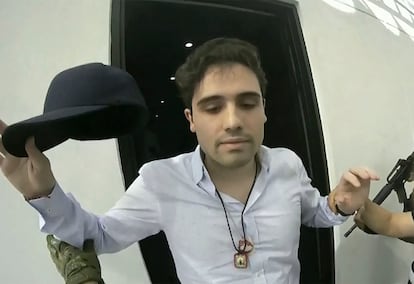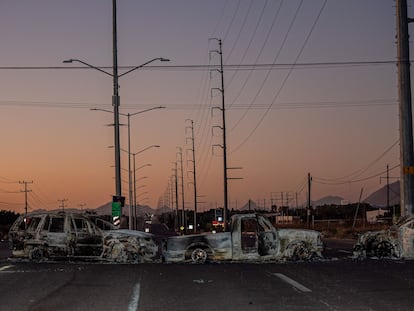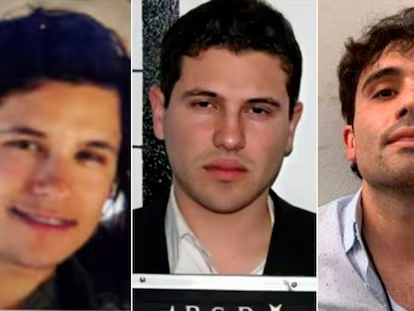‘El Chapo’ sons charged with smuggling cheap fentanyl to US
The cartel went from its first makeshift fentanyl lab to a network of labs concentrated in the northern state of Sinaloa in less than a decade

With Sinaloa cartel boss Joaquín “El Chapo” Guzmán serving a life sentence, his sons steered the family business into fentanyl, establishing a network of labs churning out massive quantities of the cheap, deadly drug that they smuggled into the U.S., prosecutors revealed in a recent indictment.
Although Guzmán’s trial revolved around cocaine shipments, the case against his sons exposes the inner workings of a cartel undergoing a generational shift as it worked “to manufacture the most potent fentanyl and to sell it in the United States at the lowest price,” according to the indictment unsealed April 14 in Manhattan.
Synthetic opioids — mostly fentanyl — now kill more Americans every year than died in the Vietnam, Iraq and Afghanistan wars combined, feeding an argument among some politicians that the cartels should be branded terrorist organizations and prompting once-unthinkable calls for U.S. military intervention across the border.
“The problem with fentanyl, as some people at the State Department told me, has to be repositioned. It’s not a drug problem; it’s a poisoning problem,” said Alejandro Hope, a security analyst in Mexico, who died Friday. “Very few people go out deliberately looking for fentanyl.”
Hope predicted fentanyl would probably become an issue in next year’s U.S. elections, but he opposed any threat of U.S. intervention, saying “I don’t think that would be a very good way of addressing a public health issue.”
The groundwork for the U.S. fentanyl epidemic was laid more than 20 years ago, with aggressive over-prescribing of the synthetic opioid oxycodone. As U.S. authorities clamped down on its prescription, users moved to heroin, which the Sinaloa cartel happily supplied.
But making its own fentanyl — far more potent and versatile than heroin — in small, easily concealed labs was a game changer. The cartel went from its first makeshift fentanyl lab to a network of labs concentrated in the northern state of Sinaloa in less than a decade.
“These are not super labs, because they give people the illusion that they’re like pharmaceutical labs, you know, very sophisticated,” said Mike Vigil, former head of international operations for the U.S. Drug Enforcement Administration. “These are nothing more than metal tubs and they use wooden paddles — even shovels — to mix the chemicals.”
A single cartel “cook” can press fentanyl into 100,000 counterfeit pills every day to fool Americans into thinking they’re taking Xanax, Percocet or oxycodone. The pills are smuggled over the border to supply what son Iván Archivaldo Guzmán Salazar said are “streets of junkies,” the indictment said.
Fentanyl is so cheap to make that the cartel reaps massive profits even wholesaling the drug at 50 cents per pill, prosecutors said.
The drug’s potency makes it particularly dangerous. The narcotic dose of fentanyl is so close to the lethal dose that a pill meant to ensure a high for a habituated user can easily kill a less experienced person taking something they didn’t know was fentanyl.
Between August 2021 and August of last year, more than 107,000 Americans died from drug overdoses, most from synthetic opioids. Last year, the DEA seized more than 57 million fentanyl-laced counterfeit prescription pills, according to the New York indictment.
To protect and expand that business, the “Chapitos,” as the sons are known, have turned to grotesque violence, prosecutors said.
Enforcers Ivan Archivaldo Guzmán Salazar and Jesus Alfredo Guzmán Salazar are the lead defendants among 23 associates charged in the New York indictment. Ovidio Guzmán López, alias “the Mouse,” who allegedly pushed the cartel into fentanyl, is charged in another indictment in the same district. Mexico arrested him in January and the U.S. government has requested extradition. Joaquín Guzmán López is charged in the Northern District of Illinois
According to the Guzmán Salazar indictment, the cartel does some lab testing on its product but conducts more grisly human testing on kidnapped rivals or addicts who are injected until they overdose.
The purity of the cartel’s fentanyl “varies greatly depending on the method and skill of the particular manufacturer,” prosecutors noted. After a user overdosed on one batch, it was still shipped to the U.S.
When the elder Guzmán and Ismael “El Mayo” Zambada led the Sinaloa cartel, it operated with a certain degree of restraint. But with Guzmán serving a life sentence and Zambada believed to be suffering from health issues, the Chapitos moved aggressively to avoid a power vacuum that could fragment the cartel.
“What was really a unique advantage of the Sinaloa cartel and El Chapo was the ability to calibrate violence,” said Vanda Felbab-Brown, a senior fellow in the Strobe Talbott Center for Security, Strategy, and Technology at the Brookings Institute.
The wide-ranging New York indictment against the Guzmán Salazar brothers details their penchant for feeding enemies to their pet tigers and describes how they tortured two Mexican federal agents, ripping through one’s muscles with a corkscrew then stuffing the holes with chile peppers before shooting him.
The indictment also provides context to some recent violence in Mexico.
In August 2022, gunmen shot up Ciudad Juarez across from El Paso, Texas. Two prison inmates and nine civilians in the city were killed. U.S. prosecutors say the Chapitos’ security arm ordered their local gang associates to commit the violence, targeting a rival cartel’s businesses.
“This is not their father’s Sinaloa cartel,” Felbab-Brown said. “These guys just operate in very different mindsets than their father.”
The Guzmán Salazar indictment makes an initial attempt at disrupting the cartel’s supply chain, naming four people tied to a China-based chemical company and a broker in Guatemala who allegedly helped the cartel get the chemicals and even instructed them on the best recipes for fentanyl.
“When they talk about labs and you’re trying to focus in on labs, that’s not going to have an impact unless you get the finished product or the precursor chemicals,” Vigil said.
Mexico’s government has stumbled through the mixed messaging of its security forces playing up their decommissioning of labs even while President Andrés Manuel López Obrador has asserted that fentanyl is not being produced in Mexico.
In congressional testimony Thursday, DEA Administrator Anne Milgram was pressed about whether Mexico and China are doing enough to cooperate with U.S.
“We want the Mexicans to work with us and we want them to do more,” Milgram said, adding that the DEA wouldn’t hesitate to go after public officials in Mexico or elsewhere should it find evidence of ties to the cartels.
Experts say López Obrador is one obstacle to slowing the cartels’ fentanyl production. After U.S. prosecutors announced the concerted effort against the Sinaloa cartel, López Obrador reacted angrily. The president accused the U.S. government of “spying” and “interference,” suggesting that the case had been built on information gathered by U.S. agents in Mexico.
The president had already severely reduced Mexico’s cooperation with the DEA, experts said.
Hope, the security analyst, said a fundamental problem is that López Obrador doesn’t appear to understand fentanyl’s threat. The president rails against a deterioration of family values in the United States and paints addiction as a moral failing.
“He’s trapped in a moral universe from 50 years ago,” Hope said.
Sign up for our weekly newsletter to get more English-language news coverage from EL PAÍS USA Edition
Tu suscripción se está usando en otro dispositivo
¿Quieres añadir otro usuario a tu suscripción?
Si continúas leyendo en este dispositivo, no se podrá leer en el otro.
FlechaTu suscripción se está usando en otro dispositivo y solo puedes acceder a EL PAÍS desde un dispositivo a la vez.
Si quieres compartir tu cuenta, cambia tu suscripción a la modalidad Premium, así podrás añadir otro usuario. Cada uno accederá con su propia cuenta de email, lo que os permitirá personalizar vuestra experiencia en EL PAÍS.
¿Tienes una suscripción de empresa? Accede aquí para contratar más cuentas.
En el caso de no saber quién está usando tu cuenta, te recomendamos cambiar tu contraseña aquí.
Si decides continuar compartiendo tu cuenta, este mensaje se mostrará en tu dispositivo y en el de la otra persona que está usando tu cuenta de forma indefinida, afectando a tu experiencia de lectura. Puedes consultar aquí los términos y condiciones de la suscripción digital.
More information
Archived In
Últimas noticias
Most viewed
- Reinhard Genzel, Nobel laureate in physics: ‘One-minute videos will never give you the truth’
- Oona Chaplin: ‘I told James Cameron that I was living in a treehouse and starting a permaculture project with a friend’
- Pablo Escobar’s hippos: A serious environmental problem, 40 years on
- Charles Dubouloz, mountaineering star, retires at 36 with a farewell tour inspired by Walter Bonatti
- Why we lost the habit of sleeping in two segments and how that changed our sense of time










































